| Here is the corresponding area as depicted on Google Earth in June 2010. As you will note, the area lies far to the north of the Arctic circle, which runs along the latitude 66 degrees 33’ 43” and represents the most southerly extent of the polar summer in the Northern Hemisphere. Thus, at the beginning of July, when this chapter takes place, Sálle and his family are enjoying perpetual daylight. You can see a graph of day lengths in Inari Finland by clicking HERE. |
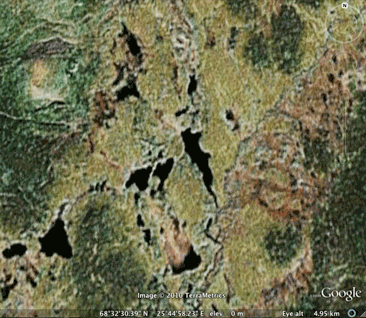 |
| This daylight regimen, as well as the brevity of the summer itself, made the months of July and August ones of feverish activity, as Sámi worked to store up food and prepare for the coming winter. As illustrated in the story, Sámi people were not bound to clock time the way many Westerners think of it today: people worked till they were tired, then slept. Mealtimes coincided with hunger, and people could eat their meals at different times from each other, depending on what work they had to do and how hungry they were at any given time. When Sálle comes home from fishing he sleeps. And once he has slept he eats, all in the same intimate environment of the goahti (see below). Sálle will learn about regimented "clock time" only once he travels south. |
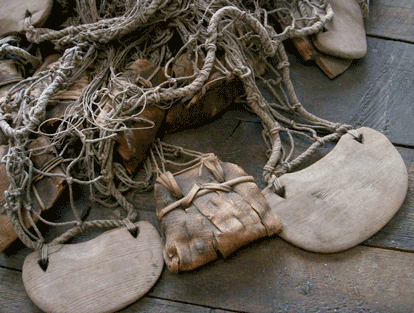 |
|
In the coming chapters, various characters will make claims about which king or realm owns the lands on which Sálle and his family live. In the fourteenth century, when the novel takes place, this issue was by no means settled. Swedes and Russians had fought a long series of battles against each other over the question of the border between their two realms, and the boundary lay somewhere in what is today Finland. The Treaty of Nöteborg/Pähkinäsaari/Orekhov/Schlüsselburg of 1323 was intended to settle the issue for once and for all, but, as you will see in coming chapters, such was not to be. According to that treaty, the Novgorod Empire owned the upper reaches of the Gulf of Finland and all the land east of it in a line extending southeastward to the area where the city of St. Petersburg exists today. As such, Sálle's home would seem to belong to the Russian realm. At the same time, however, it is known that traders and tribute takers were also circulating in the area as representatives of the Swedish and Norwegian crowns. In the early fourteenth century, as we shall see in coming chapters, these crowns belonged to a single king. Yet such does not preclude the possibility of multiple representatives of the same king visiting the same places and demanding tribute over and over again during the course of a year. These unwelcome collectors are the figures that Sálle's father refers to as the birkalash (plural birkalchat), or strangers. They took tribute in the form of furs and other goods that the Sámi were obliged to give them on an annual basis. You can read more about the early history of this region in the opening chapters of Eino Jutikkala and Kauko Pirinen's A History of Finland (Espoo: Weilin + Göös,1984) or in Jason Lavery's The History of Finland (Westport: Greenwood Press, 2006). |
|
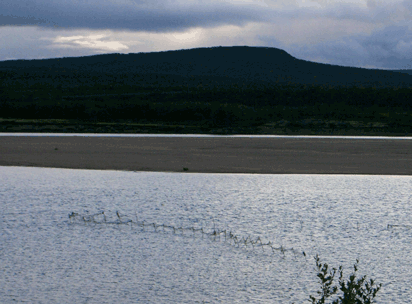 |
The area where Sálle lives belongs today to the Sallivaara paliskunta, or reindeer breeding district. Sámi in the area have made a living for centuries from a combination of reindeer herding and various other hunting and gathering activities. In the fourteenth century, Sámi in this area would have lived primarily from hunting and gathering, since large-scale reindeer herding had not yet developed in the region. Men fished intensively in the summer and hunted or trapped wild reindeer, bear, waterfowl, willow grouse, and ptarmigan. The fish which Sálle and his father catch, rávdu, are members of the trout and salmon famly known in English as the Arctic char (Salvelinus alpinus). It is the most northerly freshwater fish in the world and was a staple of traditional Sámi diets. It can grow as large as twenty pounds (nine kilograms) and its flesh is often pink or even red. Here is a picture of a fish trap like the one Sálle and his father have erected. The photo is from the Tana River, which forms the boundary between Finland and Norway today. |
|
| The furs of red fox, arctic fox, wolverine, ermine, martin, and reindeer were essential elements of clothing and well as sources of trade goods for exchange with itinerant merchants as well as the birkalachat. Fur-bearing animals were trapped in the winter, when their tracks were easier to find and their coats thicker. Furs were a prized commodity in southern Europe, as Sálle will eventually discover. Boat building also figures prominently in this chapter as an illustration of men's skills. Sámi boats were sewn of thin bands of wood much as described in the text and were thus lightweight and flexible, ideal for hauling between different rivers and lakes. This very pragmatic woodcraft will stand in contrast to the kinds of woodworking Sálle learns about when he travels south. The picture to the right is of Sámi shoes made of reindeer leg hide and stuffed with grass to make the warm. Such shoes continued to be used by Sámi right into the twentieth century. These shoes are displayed at the museum of Sámi culture in Kárašjohka, Norway. |
 |
|
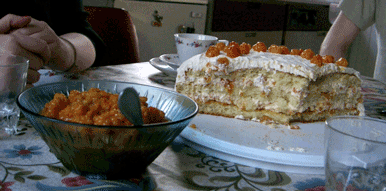 |
Women were important gatherers of food, including various berries and certain herbs like juopmu (Rumex acetosa; sorrel). They were also responsible for milking tamed reindeer and processing the milk into different foodstuffs that could be stored for the winter. In the story, we see Sálle's mother and sister mixing juopmu with reindeer milk. The high ascorbic acid (Vitamin C) content of the herb boosted the flavor, nutrition, and preservation of the milk and was a prized additive. We also see Sálle's excitement at the first arrival of luopmánat, the golden Arctic berries called cloudberries (Rubus chamaemorus). These berries grow on low, leafy plants in marshy areas where they can form thick beds that produce plentiful supplies of fruit in good years. For Sámi, these and other berries represented a seasonal delicacy as well as an important source of vitamins and nourishment. Sámi also made a tea from berry leaves to cure urinary infections. The photo here shows a modern use of cloudberries in combination with cream and sugar as a topping for fancy cakes. |
|
| |
|
|
| |
|
|
| Sálle's father is depicted performing joik singing. Joiking is a traditional song genre used to remember people, places, or beings, near or far. The singer uses voice, singing style, tone, and words to create an aural portrait of the being, making that being present in the minds of the listening audience for the duration of the song. Sálle is able to envision his sister while listening to his father's joiking. Although Sámi joik varies greatly from region to region, it generally lacks the stanzas, meter, or rhyme that one often associates with European folksong. Sálle will eventually discover the inability of people from other cultures to fully grasp or appreciate joik when he travels south. You can listen to joik singing from various parts of the Sámi region by clicking HERE. |
|
|
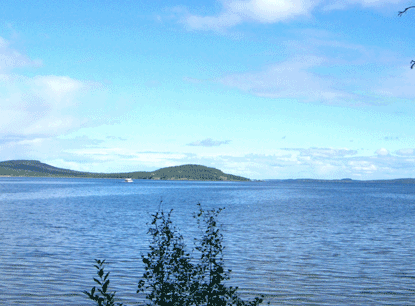 |
Finally, it is noted in the chapter that Sálle's mother comes from the area beside the great lake Ánar. Lake Inari lies to the northeast of Sállevárri and is the largest lake in the region, with an area of more than a thousand square kilometers and some three thousand islands. It has been a source of sustenance and site of dwelling for various Sámi communities for countless centuries. Sálle's mother speaks her people's form of Sámi language, which is distinct from the Northern Sámi spoken by Sálle and his father. You can read more about Sámi languages in Pekka Sammallahti's The Saami Languages: An Introduction (Kárášjohka: Davvi Girji). |
|
| |
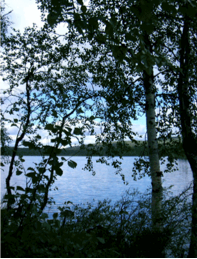 |
|
|
|
|
|
